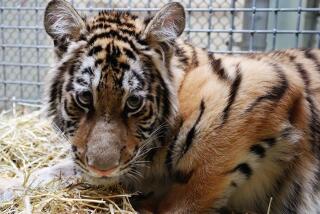National Zoo’s giant panda Mei Xiang is artificially inseminated
They closely monitored her hormone levels, watched her behavior to make sure the time was right and set up a quiet night with a mate.
But it didn’t do the trick. So on Saturday, the Smithsonian’s National Zoo performed an artificial insemination on giant panda Mei Xiang.
There is only a short window of opportunity for a giant panda to breed, so scientists at the National Zoo have been trying to make the most of it. When putting Mei Xiang and male Tian Tian together overnight didn’t result in breeding, the scientists decided to inseminate Mei Xiang with sperm collected from Tian Tian.
Last year, Mei Xiang gave birth to a female cub that lived only about a week.
Both giant pandas are at the zoo under a research and breeding agreement with the China Wildlife Conservation Assn. They are among about 300 pandas who live in zoos and breeding centers around the world. Only about 1,600 giant pandas remain in the wild.
In an update on its website, zoo officials said they were hopeful that their efforts would be successful this year.
“We’re encouraged by all the behaviors and hormonal data we’ve seen so far,” said Dave Wildt, head of the Center for Species Survival at the Smithsonian Conservation Biology Institute.
The breeding effort has attracted so much attention that it even has a hashtag of its own. The zoo promised to provide updates on Facebook and Twitter using #PandaAI.
ALSO:
Navy SEAL killed in training accident is identified
Confederate flag in North Carolina state building will come down
Former Atlanta schools chief, 34 others indicted in cheating scandal
More to Read
Start your day right
Sign up for Essential California for news, features and recommendations from the L.A. Times and beyond in your inbox six days a week.
You may occasionally receive promotional content from the Los Angeles Times.







